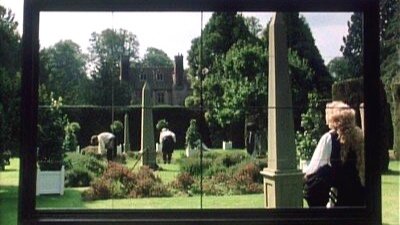The Draughtsman's Contract (1982)
![]()
Country: GB
Technical: col 108m
Director: Peter Greenaway
Cast: Anthony Higgins, Janet Suzman, Anne Louise Lambert
Synopsis:
A landowner's wife employs a draughtsman of some small repute to make twelve drawings of her husband's property in return for sexual favours.
Review:
Conceit-filled, would-be Jacobean drama with post-modernist leanings. Full of its creator's fascination for catalogues, symbolism and allegory, it provides entertainment of refined bawdiness for those even who do not share in his preoccupations. 'He paints what he sees', as one character says, so revealing the old realism/construction dichotomy as being integral to the film's debate: words like 'stratagem', 'allegory' and 'construe' litter the screenplay, implying codification and subtext as an alternative approach to art, and by extension to film. Indeed, the device of having the camera 'look' through the protagonist's frame, which is of the same aspect ratio as Greenaway's carefully chosen Super16, emphasizes how what the artist sees is restricted by his 'frame of reference', his point of view, hence his inability to read the clues to murder as potentially implicating him. A very rich undertaking, with perhaps the one shortcoming being that it does not really investigate how film distorts reality; its analogy of form and content does not extend to its own chosen form, though it is often strikingly composed and handsomely coloured.
![]()
Country: GB
Technical: col 108m
Director: Peter Greenaway
Cast: Anthony Higgins, Janet Suzman, Anne Louise Lambert
Synopsis:
A landowner's wife employs a draughtsman of some small repute to make twelve drawings of her husband's property in return for sexual favours.
Review:
Conceit-filled, would-be Jacobean drama with post-modernist leanings. Full of its creator's fascination for catalogues, symbolism and allegory, it provides entertainment of refined bawdiness for those even who do not share in his preoccupations. 'He paints what he sees', as one character says, so revealing the old realism/construction dichotomy as being integral to the film's debate: words like 'stratagem', 'allegory' and 'construe' litter the screenplay, implying codification and subtext as an alternative approach to art, and by extension to film. Indeed, the device of having the camera 'look' through the protagonist's frame, which is of the same aspect ratio as Greenaway's carefully chosen Super16, emphasizes how what the artist sees is restricted by his 'frame of reference', his point of view, hence his inability to read the clues to murder as potentially implicating him. A very rich undertaking, with perhaps the one shortcoming being that it does not really investigate how film distorts reality; its analogy of form and content does not extend to its own chosen form, though it is often strikingly composed and handsomely coloured.
![]()
Country: GB
Technical: col 108m
Director: Peter Greenaway
Cast: Anthony Higgins, Janet Suzman, Anne Louise Lambert
Synopsis:
A landowner's wife employs a draughtsman of some small repute to make twelve drawings of her husband's property in return for sexual favours.
Review:
Conceit-filled, would-be Jacobean drama with post-modernist leanings. Full of its creator's fascination for catalogues, symbolism and allegory, it provides entertainment of refined bawdiness for those even who do not share in his preoccupations. 'He paints what he sees', as one character says, so revealing the old realism/construction dichotomy as being integral to the film's debate: words like 'stratagem', 'allegory' and 'construe' litter the screenplay, implying codification and subtext as an alternative approach to art, and by extension to film. Indeed, the device of having the camera 'look' through the protagonist's frame, which is of the same aspect ratio as Greenaway's carefully chosen Super16, emphasizes how what the artist sees is restricted by his 'frame of reference', his point of view, hence his inability to read the clues to murder as potentially implicating him. A very rich undertaking, with perhaps the one shortcoming being that it does not really investigate how film distorts reality; its analogy of form and content does not extend to its own chosen form, though it is often strikingly composed and handsomely coloured.
